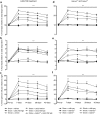Reducing excessive GABA-mediated tonic inhibition promotes functional recovery after stroke
- PMID: 21048709
- PMCID: PMC3058798
- DOI: 10.1038/nature09511
Reducing excessive GABA-mediated tonic inhibition promotes functional recovery after stroke
Abstract
Stroke is a leading cause of disability, but no pharmacological therapy is currently available for promoting recovery. The brain region adjacent to stroke damage-the peri-infarct zone-is critical for rehabilitation, as it shows heightened neuroplasticity, allowing sensorimotor functions to re-map from damaged areas. Thus, understanding the neuronal properties constraining this plasticity is important for the development of new treatments. Here we show that after a stroke in mice, tonic neuronal inhibition is increased in the peri-infarct zone. This increased tonic inhibition is mediated by extrasynaptic GABA(A) receptors and is caused by an impairment in GABA (γ-aminobutyric acid) transporter (GAT-3/GAT-4) function. To counteract the heightened inhibition, we administered in vivo a benzodiazepine inverse agonist specific for α5-subunit-containing extrasynaptic GABA(A) receptors at a delay after stroke. This treatment produced an early and sustained recovery of motor function. Genetically lowering the number of α5- or δ-subunit-containing GABA(A) receptors responsible for tonic inhibition also proved beneficial for recovery after stroke, consistent with the therapeutic potential of diminishing extrasynaptic GABA(A) receptor function. Together, our results identify new pharmacological targets and provide the rationale for a novel strategy to promote recovery after stroke and possibly other brain injuries.
Figures




Comment in
-
Stroke: recovery inhibitors under attack.Nature. 2010 Nov 11;468(7321):176-7. doi: 10.1038/468176a. Nature. 2010. PMID: 21068818 No abstract available.
-
Stroke: removing restraints on recovery.Nat Rev Drug Discov. 2011 Jan;10(1):20-1. doi: 10.1038/nrd3341. Nat Rev Drug Discov. 2011. PMID: 21193863 No abstract available.
-
Neuroplasticity: Functional recovery after stroke.Nat Rev Neurosci. 2011 Jan;12(1):4. doi: 10.1038/nrn2965. Nat Rev Neurosci. 2011. PMID: 21218570 No abstract available.
References
-
- Cramer SC. Repairing the human brain after stroke: I. Mechanisms of spontaneous recovery. Ann Neurol. 2008;63:272–287. - PubMed
-
- Brown CE, Aminoltejari K, Erb H, Winship IR, Murphy TH. In vivo voltage-sensitive dye imaging in adult mice reveals that somatosensory maps lost to stroke are replaced over weeks by new structural and functional circuits with prolonged modes of activation within both the peri-infarct zone and distant sites. J Neurosci. 2009;29:1719–1734. - PMC - PubMed
-
- Carmichael ST. Cellular and molecular mechanisms of neural repair after stroke: making waves. Ann Neurol. 2006;59:735–742. - PubMed
Methods References
-
- Barlow R. Cumulative frequency curves in population analysis. Trends Pharmacol Sci. 1990;11:404–406. - PubMed
-
- Baskin YK, Dietrich WD, Green EJ. Two effective behavioral tasks for evaluating sensorimotor dysfunction following traumatic brain injury in mice. J Neurosci Methods. 2003;129:87–93. - PubMed
-
- Schallert T, Fleming SM, Leasure JL, Tillerson JL, Bland ST. CNS plasticity and assessment of forelimb sensorimotor outcome in unilateral rat models of stroke, cortical ablation, parkinsonism and spinal cord injury. Neuropharmacology. 2000;39:777–787. - PubMed
Publication types
MeSH terms
Substances
Grants and funding
LinkOut - more resources
Full Text Sources
Other Literature Sources
Medical
Molecular Biology Databases

